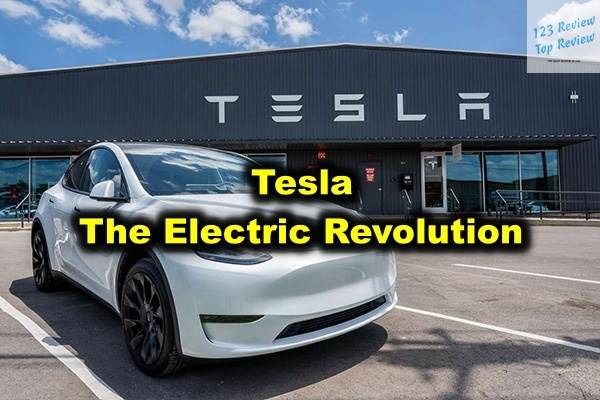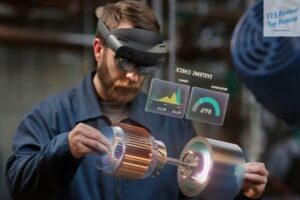In this article, 123 Review delves into Tesla’s diverse model lineup, extensive charging infrastructure, and significant sustainability efforts. It also examines Tesla’s financial performance, market influence, and ongoing advancements in AI and renewable energy integration.

This comprehensive overview highlights Tesla’s role in driving the global transition to a more sustainable and technologically advanced future.
Tesla’s Impact on the Automotive Industry
Transition to Electric Vehicles
Tesla has fundamentally transformed the automotive industry by spearheading the shift from internal combustion engines to electric vehicles (EVs). Founded in 2003 by a group of engineers who wanted to prove that EVs can be better, quicker, and more fun to drive than gasoline cars, Tesla has succeeded in making EVs not just viable but desirable. The release of the Tesla Roadster in 2008 showcased the potential of electric cars, boasting a range of 245 miles per charge, a previously unheard-of feat for EVs. This breakthrough marked the beginning of a new era, demonstrating that electric cars could be powerful, efficient, and environmentally friendly.
Innovations in Battery Technology
Central to Tesla’s success and its impact on the industry is its relentless innovation in battery technology. Tesla’s batteries are at the heart of their vehicles’ performance, offering superior energy density, longevity, and safety. The Gigafactories, massive facilities dedicated to battery production, play a crucial role in scaling up the production of these advanced batteries. The 2170 cells, developed in collaboration with Panasonic, have been a game-changer, providing higher energy density at a lower cost. The continuous research and development efforts are now focused on the next-generation 4680 cells, which promise even greater improvements in range, charging speed, and cost efficiency. These advancements not only enhance Tesla’s product lineup but also push the entire industry towards better battery solutions.
Influence on Global Automakers
Tesla’s achievements have sent ripples throughout the global automotive industry. Traditional automakers, once skeptical about the viability of electric cars, are now heavily investing in their EV programs to catch up. Companies like General Motors, Ford, Volkswagen, and BMW have announced ambitious plans to electrify their fleets, committing billions of dollars to develop new electric models and retrofit existing ones. Tesla’s market leadership has effectively raised the bar, setting new standards for performance, range, and technology that other automakers are striving to meet or exceed. This competitive pressure has accelerated the overall adoption of electric vehicles, propelling the automotive industry into a more sustainable future.
Tesla’s Model Lineup
Overview of Tesla Models
Tesla offers a diverse range of vehicles, each designed to cater to different segments of the market. The Model S, introduced in 2012, is a luxury sedan that combines performance, safety, and efficiency. The Model 3, launched in 2017, is a more affordable option designed to bring electric vehicles to the masses. The Model X, a luxury SUV, features distinctive falcon-wing doors and advanced safety features. The Model Y, a compact SUV released in 2020, offers versatility and ample cargo space. Each model is designed with Tesla’s core principles of innovation, performance, and sustainability, ensuring that there is a Tesla for every type of driver.
Performance Comparison of Tesla Vehicles
Tesla vehicles are renowned for their exceptional performance, often outperforming their gasoline-powered counterparts. The Model S Plaid, for instance, can accelerate from 0 to 60 mph in under 2 seconds, making it the fastest production car in the world. The Model 3 Performance variant offers a 0 to 60 mph time of 3.1 seconds, combining affordability with remarkable speed. The Model X, despite its size, matches many sports cars in acceleration, while the Model Y provides a perfect balance of performance and practicality. Across the board, Tesla vehicles offer industry-leading range, with the Long Range variants of the Model S and Model 3 exceeding 370 miles on a single charge. This combination of speed, range, and efficiency is a testament to Tesla’s engineering prowess.
Future Models and Predictions
Looking ahead, Tesla’s future models are generating significant excitement and anticipation. The Cybertruck, with its bold, angular design and unparalleled durability, aims to revolutionize the pickup truck segment. Promising features like ultra-hard 30X cold-rolled stainless steel and armored glass make it a standout in terms of both aesthetics and functionality. The next-generation Roadster, set to be the fastest production car ever made, boasts a top speed of over 250 mph and a 0 to 60 mph time of 1.9 seconds. Additionally, Tesla is developing the Tesla Semi, a fully electric truck that aims to improve the efficiency and sustainability of freight transport. These upcoming models highlight Tesla’s ongoing commitment to innovation and its ability to disrupt traditional automotive categories.
Tesla’s Charging Infrastructure
Supercharger Network Expansion
One of Tesla’s most significant achievements is its Supercharger network, a vast and rapidly expanding global network of fast-charging stations. As of 2024, Tesla has over 30,000 Superchargers worldwide, enabling Tesla owners to travel long distances with minimal downtime. The Supercharger V3, the latest iteration, can add up to 75 miles of range in just 5 minutes, significantly reducing charging times. This extensive network not only makes owning a Tesla more convenient but also alleviates range anxiety, a common concern among potential EV buyers. The strategic placement of Superchargers along popular travel routes ensures that Tesla drivers can enjoy seamless and uninterrupted journeys.
Home Charging Solutions
Tesla’s home charging solutions are designed to offer convenience and efficiency for daily use. The Tesla Wall Connector, compatible with all Tesla models, provides a fast and reliable charging option at home, delivering up to 44 miles of range per hour of charging. This means Tesla owners can easily charge their vehicles overnight, ensuring they start each day with a full battery. Additionally, Tesla’s Mobile Connector allows for flexible charging on the go, compatible with standard electrical outlets. These home charging options complement the Supercharger network, making Tesla ownership practical and hassle-free.
Comparison with Competitors’ Charging Options
While competitors are developing their own charging infrastructures, Tesla’s Supercharger network remains a significant competitive advantage. Networks like Electrify America and ChargePoint are expanding, but they often lag behind in terms of charging speed and reliability. Tesla’s proprietary connector and integrated navigation system, which directs drivers to nearby Superchargers, provide a seamless and user-friendly experience. Furthermore, Tesla’s ability to constantly update and optimize the Supercharger network through over-the-air updates ensures that it remains at the forefront of charging technology. This robust infrastructure is a key factor in Tesla’s continued dominance in the EV market.
Tesla’s Sustainability Efforts
Renewable Energy Integration
Tesla’s commitment to sustainability extends beyond electric vehicles to encompass renewable energy solutions. The company’s energy division, Tesla Energy, focuses on solar power generation and energy storage products. The Tesla Solar Roof, for instance, replaces traditional roofing materials with solar tiles that generate electricity. Coupled with the Powerwall, a home battery system, homeowners can store excess solar energy and use it when the sun isn’t shining. Tesla’s utility-scale energy storage solutions, such as the Powerpack and Megapack, help stabilize the grid and integrate more renewable energy sources. These initiatives not only reduce dependence on fossil fuels but also promote a more sustainable energy ecosystem.
Recycling Initiatives
Tesla is a leader in recycling initiatives, particularly in the context of battery lifecycle management. The company has developed processes to recover valuable materials from used batteries, such as lithium, cobalt, nickel, and copper. These materials are then reused in the production of new batteries, reducing the need for virgin raw materials and minimizing environmental impact. Tesla’s battery recycling programs are designed to be both efficient and environmentally friendly, ensuring that the lifecycle of its products contributes positively to sustainability goals. By focusing on closed-loop recycling, Tesla aims to create a more sustainable and circular economy.
Carbon Footprint Reduction
Tesla’s entire business model is centered around reducing the carbon footprint of transportation and energy consumption. The shift to electric vehicles powered by renewable energy significantly lowers greenhouse gas emissions compared to traditional internal combustion engine vehicles. Tesla’s continuous improvements in energy efficiency, from vehicle production to end-of-life recycling, further contribute to this goal. Additionally, Tesla’s efforts in promoting renewable energy through solar and energy storage solutions help reduce reliance on fossil fuels. Overall, Tesla’s comprehensive approach to sustainability is instrumental in combating climate change and promoting a greener future.
Tesla’s Financial Performance
Revenue Growth Trends
Tesla’s financial performance has been marked by impressive revenue growth, driven by increasing vehicle deliveries, expanding energy product sales, and the development of new markets. From its humble beginnings, Tesla has grown into one of the most valuable automakers in the world. The company’s revenue has seen consistent year-over-year growth, reflecting the strong demand for its products and the successful scaling of its production capabilities. Tesla’s ability to increase production volumes while maintaining high margins has been a key factor in its financial success.
Stock Market Performance
Tesla’s stock market performance has been nothing short of phenomenal. Listed on the NASDAQ under the ticker TSLA, Tesla’s stock has experienced significant appreciation, making it one of the most valuable companies globally. The company’s inclusion in the S&P 500 in December 2020 marked a major milestone, reflecting its importance in the broader market. Tesla’s stock performance is driven by investor confidence in its long-term vision, innovative products, and strong growth prospects. Despite the inherent volatility, Tesla’s stock continues to attract substantial interest from both retail and institutional investors.
Investment in Research and Development
A cornerstone of Tesla’s success is its substantial investment in research and development (R&D). The company spends billions annually on R&D to innovate and improve its products and technologies. This investment spans a wide range of areas, including battery technology, autonomous driving, artificial intelligence, and energy solutions. Tesla’s R&D efforts are focused on pushing the boundaries of what is possible, ensuring that it remains at the forefront of technological advancements. This commitment to innovation not only drives Tesla’s growth but also sets new standards for the industry.
Tesla’s Autonomy and Technology
Full Self-Driving (FSD) Features
Tesla’s Full Self-Driving (FSD) technology represents one of the most ambitious and advanced autonomous driving systems available. FSD enables Tesla vehicles to perform complex driving tasks with minimal human intervention. Features like Navigate on Autopilot allow the car to autonomously navigate on highways, including lane changes and interchanges. Auto Lane Change can change lanes automatically, and Traffic Light and Stop Sign Control allows the vehicle to recognize and respond to traffic signals. Tesla’s FSD technology is constantly evolving, with regular over-the-air updates that improve functionality and safety.
Advances in AI for Autonomous Driving
At the core of Tesla’s autonomous driving capabilities is its use of artificial intelligence (AI) and machine learning. Tesla’s AI approach involves using a neural network to process data from the vehicle’s sensors and cameras, enabling real-time decision-making. This system learns from billions of miles driven by Tesla vehicles worldwide, continuously improving its performance and accuracy. The Dojo supercomputer, under development, will further enhance Tesla’s AI capabilities, allowing for faster and more sophisticated training of its neural networks. These advancements position Tesla as a leader in the race towards fully autonomous vehicles.
Safety Ratings and Real-World Performance
Tesla vehicles consistently achieve high safety ratings from major testing organizations. The National Highway Traffic Safety Administration (NHTSA) and the Insurance Institute for Highway Safety (IIHS) have awarded top marks to various Tesla models for their crashworthiness and advanced safety features. Tesla’s real-world performance in terms of safety is equally impressive, with features like Autopilot and Emergency Braking significantly reducing the likelihood of accidents. Tesla’s commitment to safety is evident in its continuous efforts to enhance both passive and active safety systems, ensuring that its vehicles provide maximum protection to occupants.
In summary, Tesla’s electric revolution has reshaped the automotive industry, driving significant advancements in technology, sustainability, and financial performance. Tesla’s innovative approach to electric vehicles, charging infrastructure, and autonomous driving continues to set new benchmarks and inspire the global transition to a more sustainable future. Tesla’s comprehensive efforts in battery technology, renewable energy integration, and sustainability initiatives position it as a leader in the quest for a greener and more efficient world. As Tesla continues to push the boundaries of what is possible, its impact on the automotive industry and beyond is likely to grow even more profound.





